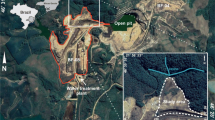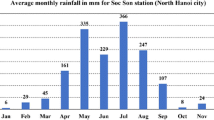Abstract
Mineral exploration is often associated with the generation of environmental liabilities, whose potential damages might imperil local water quality. An example of these environmental impacts is the acid mine drainage—AMD, caused by sulfides oxidation and production of acid and saline effluents. The analysis of critical areas with generation and spread of contamination plumes becomes more feasible due to the possibility to obtain geophysical models of water systems, especially to identify regions with accumulation of reactive minerals and preferential water flows. The rock-waste pile named BF-04 fits in this context of contamination, and it was studied based on the Electrical Resistivity Tomography technique, inversion models and isosurface models, providing conditions to recognize sulfide zones (> 10.1 mV/V), whereas chaotic high salt content underground flows, along several depths, were identified by low resistivity zones (< 75.8 Ω m). The complex behavior of groundwater flow in this kind of artificial granular aquifer is caused by its granulometric and lithologic heterogeneities, and compacted material. In addition, the results reveled a substantial water infiltration from Consulta creek, however the most critic zones for AMD generation are located at shallow levels where the waste rock material is more exposed to atmospheric O2 and meteoric water infiltration. The bedrock was not associated with significant low resistivity anomalies, which means that its contribution to AMD generation was considered relatively less important. The results will contribute to the environmental remediation management and also to demonstrate the potential applicability of geophysical methods in mining wastes.












Similar content being viewed by others
References
ABEM. (2012). Terrameter LS—Instruction manual (p. 122). Sundbyberg: ABEM Instrument AB.
Aizebeokhai, A. P., Olayinka, A. I., Singh, V. S., & Uhuegbu, C. C. (2011). Effectiveness of 3D geoelectrical resistivity imaging using parallel 2D profiles. International Journal of the Physical Sciences,6, 5623–5647.
Akcil, A., & Koldas, S. (2006). Acid mine drainage (AMD): Causes, treatment and case studies. Journal of Cleaner Production,14(12), 1139–1145.
Alberti, H. L. C. (2017). Estudo hidroquímico e isotópico das águas subterrâneas impactadas pela drenagem ácida da mina de urânio—Osamu Utsumi, Planalto de Poços de Caldas (MG). Masters Dissertation—Universidade Estadual de Campinas, Campinas, p. 194.
Anterrieu, O., Chouteau, M., & Aubertin, M. (2010). Geophysical characterization of the large-scale internal structure of a waste rock pile from a hard rock mine. Bulletin of Engineering Geology and the Environment,69, 533–548.
Bania, G., & Cwiklik, M. (2013). 2D electrical resistivity tomography interpretation ambiguity—Example of field studies supported with analogue and numerical modelling. Geology, Geophysics & Environment,39(4), 331–339.
Belmonte-Jiménez, S. I., Jiménez-Castañeda, M. E., Pérez-Flores, M. A., Campos-Enríquez, J. O., Reyes-López, J. Á., & Salazar-Peña, L. (2012). Characterization of a leachate contaminated site integrating geophysical and hydrogeological information. Geofísica Internacional,51(4), 309–321.
Benson, A. K., Payne, K. L., & Stubben, M. A. (1997). Mapping groundwater contamination using dc resistivity and VLF geophysical methods. Geophysics,62(1), 80–86.
Bermejo, J. L., Sauck, W. A., & Atekwana, E. A. (1997). Geophysical discovery of a new LNAPL plume at the former Wurtsmith AFB. Ground Water Monitoring Remediation,17(4), 131–137.
Blowes. D. W. (1997). The environmental effects of mine wastes. In Proceedings of exploration 97: Fourth decennial international conference on mineral exploration (Vol. 4, 887–892). Toronto: Prospectors and Developers Association.
Campaner, V. P., & Silva, W. L. (2009). Processos físico-químicos em drenagem ácida de mina em mineração de carvão. Quimica Nova,32(1), 146–152.
Campbell, D. L., Beanland, S. (2001). Spectral induced polarization measurements at the Carlisle mine dump (p. 11). New Mexico: U.S. Geological Survey Open-File Report, 01-363.
Campbell, D. L., Fitterman, D. V. (2000). Geoelectrical methods for investigating mine dumps. In Fifth international conference on acid rock drainage (pp. 1513–1523). Denver: ICARD.
Chambers, J. E., Kuras, O., Meldrum, P. I., Ogilvy, R. D., & Hollands, J. (2006). Electrical resistivity tomography applied to geologic, hydrogeologic, and engineering investigations at a former waste-disposal site. Geophysics,71, 231–239.
Cipriani, M. (2002). Mitigação dos Impactos Sociais e Ambientais Decorrentes do Fechamento Definitivo de Minas de Urânio. Ph.D. Thesis—Universidade Estadual de Campinas—Instituto de Geociências, Campinas, p. 332.
Delgado-Rodriguez, O., Florez-Hernandez, D., Amezcua-Allieri, M. A., Rosas-Molina, A., & Marin-Cordova, S. (2014). Joint interpretation of geoelectrical and volatile organic compounds data: A case study in a hydrocarbons contaminated urban site. Geofísica Internacional,53(2), 183–198.
Fagundes, J. R. T. (2005). Balanço hídrico do bota—fora BF4 da mina Osamu Utsumi, INB, como subsídio para projetos de remediação de drenagem ácida. MS Dissertation, Universidade Federal de Ouro Preto, Ouro Preto, p. 121.
Fala, O., Aubertin, M., Molson. J., Bussière, B., Wilson, G. W., Chapuis, R. P., Martin, V. (2003). Numerical modeling of unsaturated flow in uniform and heterogeneous waste rock piles. In 6th international conference on acid rock drainage, Cairns.
Fraenkel, M. O., Santos, R. C., Loureiro, F. E. V. L., Muniz, W. S. (1985). Jazida de Urânio no Planalto de Poços de Caldas—Minas gerais. In Departamento Nacional de Produção Mineral. Principais Depósitos Minerais do Brasil: Recursos Minerais Energéticos. Brasília: DNPM, 1, cap. 5, pp. 89–103.
Franklin, M. R. (2007). Modelagem numérica do escoamento hidrológico e dos processos geoquímicos aplicados à previsão da drenagem ácida em uma pilha de estéril da mina de urânio de Poços de Caldas, MG. Ph.D. Thesis, Universidade Federal do Rio de Janeiro, Rio de Janeiro, p. 358.
Freitas, C. M., Silva, M. A., & Menezes, F. C. (2016). O desastre na barragem de mineração da Samarco—Fratura exposta dos limites do Brasil na redução de risco de desastres. Ciência e Cultura,68(3), 25–30.
Gray, N. F. (1997). Environmental impact and remediation of acid mine drainage: a management problem. Environmental Geology,30, 62–71.
Helene, L. P. I., Moreira, C. A., & Carrazza, L. P. (2016). Applied geophysics on a soil contaminated site by chromium of a tannery in Motuca (SP). Revista Brasileira de Geofísica,34, 309–317.
Holmes, D. C., Pitty, A. E., & Noy, D. J. (1992). Geomorphological and hydrogeological features of the Poços de Caldas caldera analogue study sites. Journal of Geochemical Exploration,45, 215–247.
Kearey, P., Brooks, M., Hill, I. (2002). An introduction to geophysical exploration. In Tradução de Maria Cristina Moreira Coelho (1st ed., p. 429). São Paulo: Oficina de Textos.
Knodel, K., Lange, G., & Voift, H. J. (2007). Environmental geology—Handbook of field methods and case studies (p. 1357). Germany: Springer.
Lacaz, F. A. C., Porto, M. F. S., & Pinheiro, T. M. M. (2016). Tragédias brasileiras contemporâneas: o caso do rompimento da barragem de rejeitos de Fundão/Samarco. Revista brasileira de saúde ocupacional,42(9), 1–12.
Leite, J. S. M. (2010). Previsão de drenagem ácida por meio de testes estáticos do material do bota fora da mina de Osamu Utsumi—Caldas, MG. Masters Dissertation—Universidade Federal de Ouro Preto. Escola de Minas. Departamento de Geologia, Ouro Preto, p. 59.
Loke, M. H. A. (2010). Practical guide 2-D and 3-D surveys. In Electrical imaging surveys for environmental and engineering studies (p. 136).
Loke, M. H., & Baker, R. D. (1996). Rapid least-squares inversion of apparent resistivity pseudosections by quasi-Newton method. Geophysical Prospecting,44, 131–152.
Lopes, L. M. N. (2016). The rupture of the Mariana dam and its social-environmental impacts. Sinapse Múltipla,5(1), 1–14.
Lowrie, W. (2007). Fundamentals of geophysics (Segunda edição ed., p. 381). Cambridge: Cambridge University Press.
Lowson, R. T. (1982). Aqueous oxidation of pyrite by molecular oxygen. Chemical Reviews,82(5), 461–497.
Merkel, R. H. (1972). The use of resistivity to delineate acid mine drainage in ground water. Ground Water,10(5), 38–42.
Milson, J. (2003). Field geophysics (p. 232). England: Wiley.
Moraes, F. T., & Jiménez-Rueda, J. R. (2008). Fisiografia da região do planalto de Poços de Caldas, MG/SP. Revista Brasileira de Geociências,38(1), 196–208.
Moreira, A. C., & Braga, A. C. O. (2009). Aplicação de métodos geofísicos no monitoramento de área contaminada sob atenuação natural. Revista Brasileira de Engenharia Sanitária e Ambiental,14(2), 257–264.
Moreira, A. C., Carrara, A., Helene, L. P. I., Hansen, M. A., Malagutti Filho, W., & Dourado, J. C. (2017). Electrical resistivity tomography (ERT) applied in the detection of inorganic contaminants in suspended aquifer in Leme City (Brazil). Revista Brasileira de Geofísica,35(3), 213–225.
Moreira, C. A., Lapola, M. M., & Carrara, A. (2016). Comparative analyzes among electrical resistivity tomography arrays in the characterization of flow structure in free aquifer. Geofísica Internacional,55(2), 119–129.
Moreira, C. A., Paes, R. A. S., Ilha, L. M., & Bittencourt, J. C. (2018). Reassessment of copper mineral occurrence through electrical tomography and pseudo 3D modeling in Camaquã Sedimentary Basin, Southern Brazil. Pure and Applied Geophysics,175, 1431–1445.
Mussett, A. E., & Khan, M. A. (2000). Looking into the earth: an introduction to geological geophysics (p. 470). New York: Cambridge University Press.
Naidoo, S. (2017). The global context of AMD. In: Acid mine drainage in South Africa, Springer briefs in environmental science (pp. 9–17).
Pastore, E. L., & Mioto, J. A. (2000). Impactos ambientais em mineração com ênfase à Drenagem Mineira Ácida e transporte de contaminantes. Revista Solos e Rochas,23(1), 33–56.
Pichtel, J. R., & Dick, W. A. (1991). Sulfur, iron and solid phase transformations during biological oxidation of pyritic mine spoil. Solid Biology & Biochemistry,23, 101–107.
Power, C., Tsourlos, P., Ramasamy, M., Nivorlis, A., & Mkanda Wire, M. (2018). Combined DC resistivity and induced polarization (DC-IP) for mapping the internal composition of a mine waste rock pile in Nova Scotia, Canada. Journal of Applied Geophysics,150, 40–51.
Pyrcz, M. J., & Deutsch, C. V. (2014). Geostatistical reservoir modeling (p. 449). New York: Oxford University Press.
Santos, S. F. (2017). Caracterização de ocorrência de cobre por meio de levantamento estrutural e geofísico em faixa de dobramentos na região de Caçapava do Sul (RS). Masters Dissertation—Universidade Paulista Júlio de Mesquita Filho, IGCE, Rio Claro, p. 79.
Targa, D. A., Moreira, C. A., Camarero, P. L., Casagrande, M. F. S., & Alberti, H. L. C. (2019). Structural analysis and geophysical survey for hydrogeological diagnosis in uranium mine, Poços de Caldas (Brazil). SN Applied Sciences,1(299), 1–12.
Thedeschi, M. F., Vieira, P. L. N. C. R., Nomo, T. A. (2015). Projeto fronteiras de Minas Gerais: Folha Caldas/Poços de Caldas, escala 1:100.000. Universidade Federal de Minas Gerais, p. 78.
Veloso, D. I. K., Moreira, C. A., & Côrtes, A. R. P. (2015). Integration of geoelectrical methods in the diagnostic of a diesel contaminated site in Santa Ernestina (SP, Brazil). Revista Brasileira de Geofísica,33(4), 667–676.
Vieira, L. B., Moreira, C. A., Côrtes, A. R. P., & Luvizotto, G. L. (2016). Geophysical modeling of the manganese deposit for Induced Polarization method in Itapira (Brazil). Geofísica Internacional,55(2), 107–117.
Vogelsang, D. (1995). Environmental geophysics: A practical guide (p. 173). Berlin: Springer.
Yuval, D., & Oldenburg, W. (1996). DC resistivity and IP methods in acid mine drainage problems: results from the Copper Cliff mine tailings impoundments. Journal of Applied Geophysics,34, 187–198.
Acknowledgements
The authors are thankful to São Paulo Research Foundation (FAPESP), for the financial support whereby process number 2018/14565-3 (Regular Project), the Applied Geology Department of UNESP—Rio Claro for the availability of the geophysical equipment and the Brazilian Nuclear Industries (Indústrias Nucleares do Brasil-INB) for the provided access to the study area.
Author information
Authors and Affiliations
Corresponding author
Additional information
Publisher's Note
Springer Nature remains neutral with regard to jurisdictional claims in published maps and institutional affiliations.
Rights and permissions
About this article
Cite this article
Casagrande, M.F.S., Moreira, C.A. & Targa, D.A. Study of Generation and Underground Flow of Acid Mine Drainage in Waste Rock Pile in an Uranium Mine Using Electrical Resistivity Tomography. Pure Appl. Geophys. 177, 703–721 (2020). https://doi.org/10.1007/s00024-019-02351-9
Received:
Revised:
Accepted:
Published:
Issue Date:
DOI: https://doi.org/10.1007/s00024-019-02351-9




